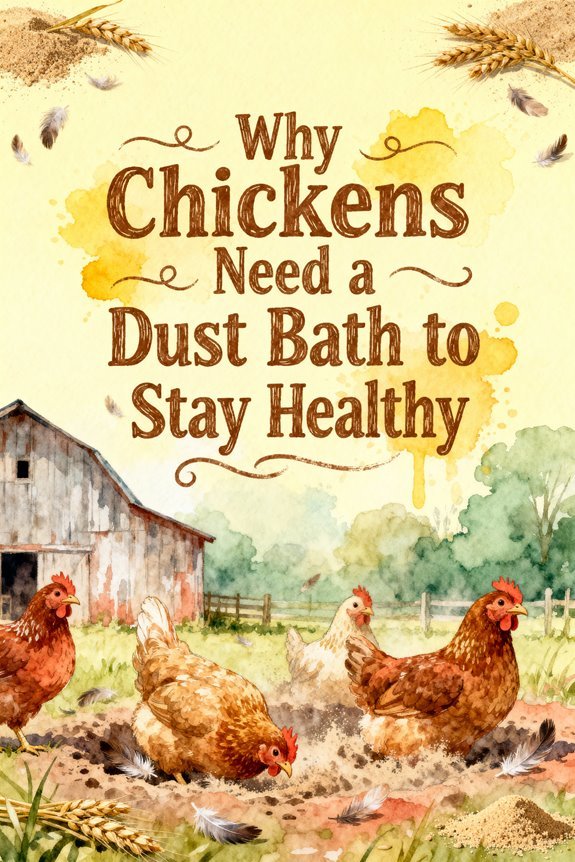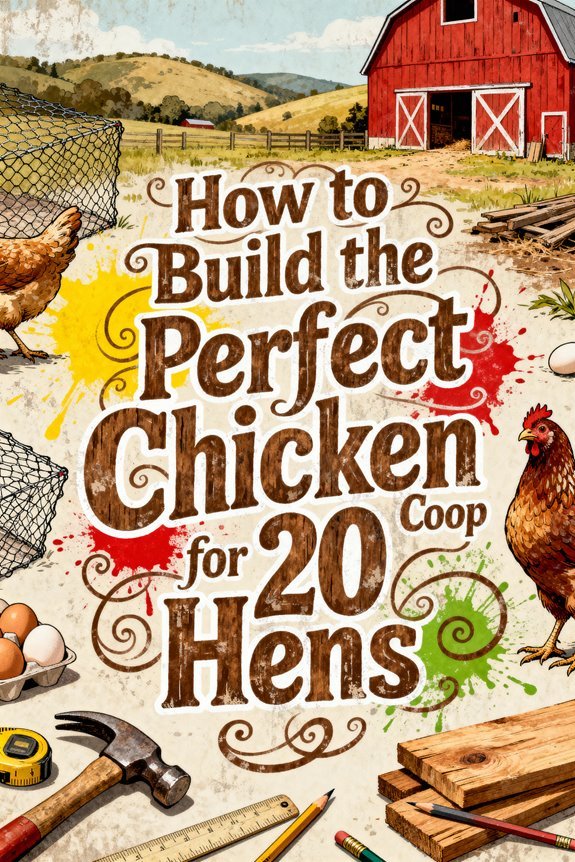Can Chickens Safely Eat Cabbage as Part of Their Diet?
You can safely feed cabbage to your chickens as a nutritious treat that provides essential vitamins K and C, minerals, and dietary fiber. To enhance benefits, tear or chop the leaves into manageable pieces and limit servings to 10-20% of their total diet. Hang whole cabbage heads to encourage natural foraging behavior and exercise. While cabbage offers excellent nutritional value, understanding proper feeding guidelines guarantees ideal health outcomes for your flock.
The Nutritional Value of Cabbage for Chickens
While cabbage serves as a nutritious supplement in chicken diets, its primary value lies in its rich micronutrient profile rather than its macronutrient content. You’ll find that cabbage’s nutrient density stems from its diverse vitamin benefits, particularly its high concentration of Vitamin K (85% RDI) and Vitamin C (54% RDI), along with beneficial B-vitamins like folate and B6. Among its abundant micronutrients, riboflavin aids respiration at the cellular level.
The macronutrient composition reveals low caloric content at 22 calories per cup, with minimal protein (1g) and negligible fat. However, the 2g of dietary fiber per serving supports digestive health. You’ll also find essential minerals including manganese, potassium, calcium, and magnesium, though in moderate amounts. The presence of antioxidants, including polyphenols and sulfur compounds, further enhances cabbage’s nutritional profile by supporting immune function and cellular health in your chickens.
Safe Feeding Guidelines and Best Practices
Although cabbage offers nutritional benefits for chickens, implementing proper feeding guidelines promotes ideal health outcomes and prevents potential digestive issues. You’ll need to limit feeding frequency to occasional treats rather than daily offerings, and tear leaves into manageable pieces for easier consumption. Proper cabbage storage in cool conditions maintains freshness and nutritional integrity. For young chicks, cook or chop cabbage thoroughly to minimize potential choking risks.
When serving cabbage, remove damaged outer leaves and avoid seasoning with salt or spices. You can offer it raw to preserve nutrients or hang whole heads for enrichment, but monitor consumption to prevent overfeeding. If using cabbage during summer months, its high water content supports hydration, but make certain it doesn’t replace commercial feed or fresh water. Always introduce cabbage gradually and watch for individual sensitivities in your flock. Like other leafy greens, cabbage should be introduced after chicks reach six weeks old to protect their delicate digestive systems. The vegetable’s vitamin K content makes it particularly beneficial for maintaining healthy bone development in your flock.
Health Benefits and Disease Prevention
Cabbage’s remarkable health benefits extend far beyond its role as a dietary supplement for chickens. The vegetable’s rich antioxidant content, particularly vitamin C, provides essential immune support by protecting cells from oxidative damage and enhancing immunological responses. These antioxidant benefits help combat inflammation and reduce chronic disease risks in your flock.
Due to its unique ability to soothe stomach ulcers, cabbage can promote healthy digestion in chickens. The vegetable’s high fiber content promotes cardiovascular health by managing cholesterol levels and supporting stable blood glucose. Additionally, vitamin K and mineral content contribute to bone density maintenance, while the fiber improves gut health by supporting beneficial microbiota and preventing digestive issues. When you incorporate cabbage into your chickens’ diet, you’re providing them with an extensive range of nutrients that enhance their natural disease resistance and support their overall metabolic functions.
Behavioral Enrichment Through Cabbage Feeding
Beyond its nutritional value, incorporating cabbage as an enrichment tool provides multiple behavioral benefits for your chickens. Creating a cabbage tetherball encourages natural foraging instincts while redirecting potentially destructive pecking behaviors. Your flock will experience enhanced sensory stimulation through the varied textures, smells, and sounds of the hanging vegetable.
This interactive feeding method promotes physical exercise as your chickens stretch and maneuver to access the suspended cabbage. You’ll notice improved cognitive engagement as they problem-solve to reach their treat, similar to puzzle feeders used in other animals. Regular variation of treat delivery helps prevent boredom in your flock. The shared resource also influences social dynamics, fostering flock cohesion while providing opportunities for natural hierarchy expression. By regularly rotating fresh cabbage, you’ll maintain novelty and prevent habituation, ensuring sustained enrichment benefits.
Potential Risks and Limitations
While cabbage offers nutritional benefits for chickens, several potential risks require careful consideration. Pesticide residues from conventional farming can accumulate in your flock’s system, leading to long-term health issues. You’ll need to source organic or pesticide-free cabbage to guarantee safety. Digestive issues may arise from excessive consumption, including diarrhea and crop impaction, particularly when feeding large pieces. Monitor your chickens’ tolerance by introducing cabbage gradually.
Cabbage requires prompt clean-up of uneaten portions to prevent mold growth and respiratory issues in your flock. Be vigilant about ingredient additives and toxicity concerns – avoid feeding cabbage with salt, seasonings, or cooking fats, as these can cause severe health complications. You’ll also need to maintain strict quantity limits and control feeding frequency, treating cabbage as an occasional treat rather than a dietary staple to prevent nutrient imbalances and digestive disruptions.
Impact on Egg Production and Quality
Having addressed the risks, it’s worth examining how cabbage affects egg production and quality metrics. Research indicates that incorporating dried cabbage leaves into laying hen diets maintains egg production rates at 94-96%, with no adverse effects on productivity. You’ll find that cabbage benefits extend to egg quality parameters, as studies show stable egg weights and enhanced yolk pigmentation that appeals to consumers.
The nutritional composition of cabbage, rich in vitamins K, C, B6, and antioxidants, supports overall hen health and egg formation. You can expect improved yolk color and potentially reduced cholesterol levels in eggs from cabbage-fed hens. When fed to layer chickens in the afternoon hours, cabbage serves as an excellent dietary supplement without diminishing their regular feed intake. Additionally, the fiber content aids digestive health, while anti-inflammatory compounds help maintain consistent laying performance by reducing systemic inflammation that could impair production.
Different Ways to Serve Cabbage to Your Flock
As you establish a cabbage feeding regimen for your flock, several scientifically-validated serving methods can enhance nutrient intake and minimize waste. You’ll find that hanging techniques using ropes, carabiners, or hooks position cabbage at ideal head height, promoting natural foraging behaviors while reducing ground contamination. This “chicken tetherball” approach serves as both nutrition and enrichment. Providing essential vitamins and minerals through cabbage helps support egg production and overall chicken health.
For temperature regulation, refrigerated raw cabbage pieces provide hydration during summer, while lightly steamed portions offer warmth in winter. Cooking methods should exclude seasonings and minimize nutrient loss. You can enhance accessibility by chopping cabbage into size-appropriate pieces, particularly for younger birds. When implementing these serving strategies, start with smaller portions and gradually increase quantities as your chickens adapt to this dietary addition.
Seasonal Considerations for Cabbage Feeding
Since seasonal changes substantially impact chickens’ nutritional needs, you’ll need to adjust your cabbage feeding strategy throughout the year. During summer months, increase cabbage servings to 1-2 times weekly to combat heat stress and support hydration. The water-rich vegetable helps regulate body temperature when environmental stressors are highest. The high vitamin C content makes cabbage particularly beneficial during stressful seasonal transitions.
In winter, reduce feeding frequency to once weekly, primarily for enrichment purposes. You’ll need to monitor seasonal availability disruptions that might affect your cabbage sourcing and storage capabilities. Summer’s heat accelerates spoilage, while winter presents freezing risks. Maintain feeding portions at 10-20% of total dietary intake regardless of season, and adjust preparation methods accordingly—raw, chopped pieces work best in summer, while hanging whole heads provides better winter enrichment.
Signs of Healthy Cabbage Consumption
While monitoring your chickens’ response to cabbage feeding, you’ll need to observe specific physical and behavioral indicators that confirm healthy consumption patterns. Watch for vibrant plumage, firm droppings, and consistent energy levels, which demonstrate proper nutritional absorption. Your flock should maintain regular foraging behavior and show increased interest in cabbage portions without signs of digestive distress.
Key physiological markers include improved egg production with stronger shells, healthier comb coloration, and stable weight maintenance. Successful cabbage digestion is evidenced by normal crop function, balanced gut microbiota, and absence of impaction when portions are limited to 10-20% of diet. You’ll also notice enhanced immune response through reduced inflammation symptoms and better feather condition, indicating ideal nutrient utilization from the cabbage supplementation. Chickens benefit greatly from cabbage’s rich content of fiber and vitamins, making it an excellent addition to their regular diet.
Balancing Cabbage With Other Feed Types
To maintain ideal flock health, you’ll need to integrate cabbage strategically with protein-rich feeds and energy sources in your chickens’ diet. Since cabbage lacks sufficient protein content, you’ll want to combine it with grains, legumes, or commercial feed to guarantee proper nutrition. The key to successful feed combinations lies in preserving the balance of essential nutrients while incorporating cabbage as a supplement. The vegetable’s high fiber content supports healthy digestion in your flock. Similar to how vitamin-rich parsley supports immune health, cabbage can be a beneficial addition to your chickens’ diet.
For meat birds specifically, using crumble or pellets can improve feed efficiency when combining with cabbage. You’ll achieve excellent cabbage nutrition by guaranteeing calcium-rich feeds remain prominent in the diet for strong eggshell production. When mixing feed types, maintain adequate protein levels through diverse ingredients rather than relying heavily on cabbage. This approach prevents nutrient deficiencies while allowing your flock to benefit from cabbage’s vitamins, minerals, and fiber content without compromising their overall dietary requirements.





